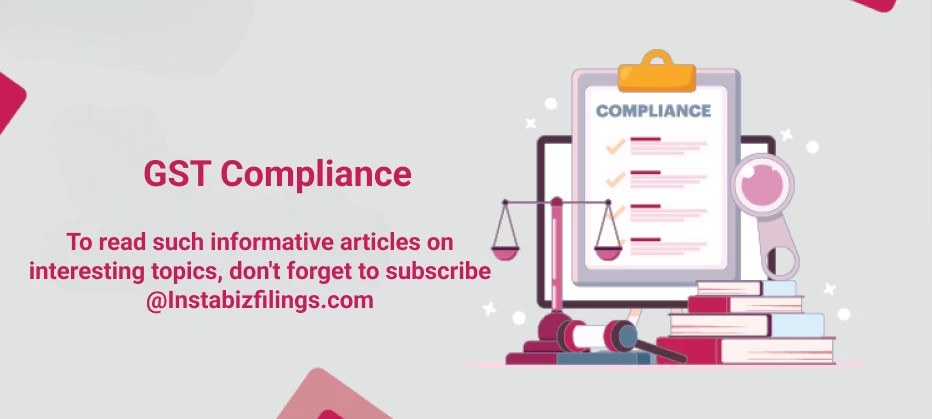
GST Compliance
June 25, 2025 by Team Instabizfilings
What is GST Compliance?
GST Compliance can be defined as the legalities and formalities that the businesses are required to abide by in the Goods and Services Tax (GST) regime. GST is an indirect tax which is imposed on the sale of goods and services in a large number of countries such as India, Canada and Australia among others. GST compliance makes sure that businesses are maintaining the requirements of reporting, paying, and filing taxes correctly and within the due date.
It is important that the GST compliance is done by businesses to prevent penalties, interest and legal complications. It comprises keeping appropriate records, delivering invoices containing appropriate GST information, lodging returns on a timely basis and making appropriate payment of the GST collected from the customers to the government.
Key Aspects of GST Compliance
- Who Needs to Register: There is a certain threshold limit above which businesses have to mandatorily register themselves GST. However, small businesses can get voluntary registration.
- Types of Registration:
- Regular GST Registration: For businesses that do not qualify for special schemes and deal with larger amounts of business.
- Composition Scheme: A simpler system is offered to small businesses whose turnover does not exceed the established limit. Tax rate is lower in the scheme but there is no input tax credit (ITC) allowed.
- Each taxable supply should be supported by a valid GST invoice which should contain some vital information like:
- GST registration number (GSTIN)
- Customer details
- GST rate applied
- Value of goods or services sold
- Taxes (CGST, SGST, IGST) applicable
2. The design of the GST invoice is standardised and the information ought to be in accordance with the nature of the goods or services that are being sold.
-
GST Returns:
- Based on their operation, businesses are required to make a number of GST returns.The returns are either filed monthly or quarterly, whichever is the case depending on the nature of the business.
- Common GST returns include:
-
Input Tax Credit (ITC):
- A GST paid on purchases and other expenses that are used in the business can be claimed as an Input Tax Credit by businesses. This brings down the GST liability.
- To avail ITC, it is imperative that GST in respect of purchase, made by the businesses is correctly reflected in the GST returns and that tax invoice is as per the GST provisions.
- Once the GST returns have been filed, then the businesses would make payment of the GST to the government. The GST can be paid in the authorised banks or via the online portals.
- The net GST liability that has to be paid by the business is the difference between the GST charged to the customers and the GST paid on purchases (ITC).
-
GST Audit and Assessment:
- GST Audit: Based on the turnover, the business might be required to have a GST audit by the GST-authorized auditor. This is to make sure that the GST returns that the business declares are in line with the actual transactions.
- GST Assessment: Where there are differences or failure to comply, the tax authority has the option of conducting an assessment to see whether the business is complying with the GST laws and regulations.
GST Compliance Process
The process of GST compliance consists of a few steps, which make sure that businesses are acting by the law:
- GST Registration
- Eligibility Check: Check whether your business requires to be registered GST depending upon your turnover and nature of products/services you sell.
- Online Registration: GST registration can be done by approaching the official GST portal where a business has to fill in basic information about the business like the name of the name of the business, address, PAN and nature of the business.
- Obtain GSTIN: Once the registration is done, the businesses will be given a unique GST Identification Number (GSTIN) that has to be quoted on every invoice and GST returns.
- GST Invoicing
- Issue Proper Invoices: Businesses have to issue a GST-compliant invoice with regard to every taxable sale. The charged tax amount must be mentioned on the invoice, as well as other obligatory information (GSTIN, HSN/SAC code, etc.).
- Maintain Records: Maintenance of proper records of invoices, bills and receipts (GST purpose). Such records will be needed in case of audits or assessment.
- Choose Filing Frequency: You will be required to lodge monthly, quarterly or annual GST returns depending on your business turnover and the kind of tax regime you are in.
- File GSTR-1 (Sales): Provide the particulars of all the external supplies (sales) of the period.
- File GSTR-2 (Purchases): This return contains information regarding the inward supplies (purchases) of goods or services.
- File GSTR-3B (Monthly Summary): This summary return is the most serious filing, because it gives a picture of the taxes due or refunded during the period. It should be registered on a monthly basis.
- Payment of GST
- Calculate Tax Payable: Calculate your total GST liability after deducting the Input Tax Credit (ITC).
- Make Payment: To avoid late fees and penalty pay the outstanding GST through the official portal before the due date.
- Reconcile Payment with Returns: Make sure that the GST paid is well indicated in the returns filed and is equal to the amounts payable.
- Record Keeping and Documentation
- Proper Documentation: Keep a proper record of all transactions relating to GST invoices, purchase orders, payment receipts, etc. at least 6-8 years as stipulated by law.
- Audit and Verification: During audits or assessments, make available all the documentation to prove the GST paid and collected, and the correctness of returns that were filed.
Importance of GST Compliance
-
Legal Protection: Businesses that meet the GST regulations can avoid legal implications, fines and penalties. Failure to comply may lead to huge financial penalties and interests or even suspension of GST registration.
-
Avoiding Penalties and Interest: Penalties, interest, prosecution can be imposed in case of late filing of returns, delayed payments or wrong GST filings. Compliance keeps the businesses in the good books of the tax authorities.
-
Claiming Input Tax Credit (ITC): The businesses that are GST compliant can also claim the input tax credit of the tax paid on purchases that reduces the tax burden. Nevertheless, to take ITC, companies should make sure that their invoices are all correct and valid.
-
Transparency and Record Keeping: The GST compliance procedure is fostering the improvement of records-keeping and lighting up business dealings, which enhances business effectiveness and decreases the fraud risk.
-
Smooth Operations: Businesses that are compliant are in a position to conduct business without any interruption as a result of tax disputes, assessments and audits.
GST Compliance Challenges
-
Complexity of Returns: The process of filing more than one GST returns (GSTR-1, GSTR-3B, GSTR-9, etc.) may be confusing, especially when it comes to large businesses that have numerous transactions.
-
Maintaining Proper Records: GST compliance requires keeping of accurate records. Small businesses may find it difficult to manage the records of purchases, sales and invoices.
-
Frequent Changes in GST Laws: The GST system is constantly changing through new legislation, tax rates and compliance conditions. It requires businesses to keep up to date so that they can be on the safe side.
-
Technology Integration: Other businesses might find it harder to install GST compliant software or accounting packages particularly those businesses that are in traditional sectors or have low access to technology.
How to Ensure GST Compliance
-
Adopt GST-Compliant Software: Use accounting software or ERP systems that integrate GST compliance features, including automatic tax calculations, invoice generation, and returns filing.
-
Regular Training: You should make sure that your employees receive training on GST laws, invoicing process, and filing to minimize mistakes.
-
Stay Updated: Stay informed of any variations in GST legislation and regulations by subscribing to tax official updates or engagement of a tax expert.
-
Consult a GST Practitioner: And even if you are not certain that you are GST compliant, then you had better seek the services of a qualified GST practitioner or GST consultant who would help you in clarifying that you are up to all the legal requirements.
Conclusion
GST Compliance becomes one of the necessary conditions of operating business, which involves goods or services that are liable to tax. The correct compliance means the businesses do not fall in legal problems, penalties and make the maximum tax benefits like claiming the Input Tax Credit. Businesses will remain compliant by undertaking the following steps during registration, invoicing, returns filing and payments to remain compliant and efficient under the GST regime.
Businesses should keep on reviewing and evaluating their GST practices, keep abreast with tax changes, and employ the right tools and services that make the process a breeze.
Disclaimer
The information provided in this blog is purely for general informational purposes only. While every effort has been made to ensure the accuracy, reliability and completeness of the content presented, we make no representations or warranties of any kind, express or implied, for the same.
We expressly disclaim any and all liability for any loss, damage or injury arising from or in connection with the use of or reliance on this information. This includes, but is not limited to, any direct, indirect, incidental, consequential or punitive damage.
Further, we reserve the right to make changes to the content at any time without prior notice. For specific advice tailored to your situation, we request you to get in touch with us.


